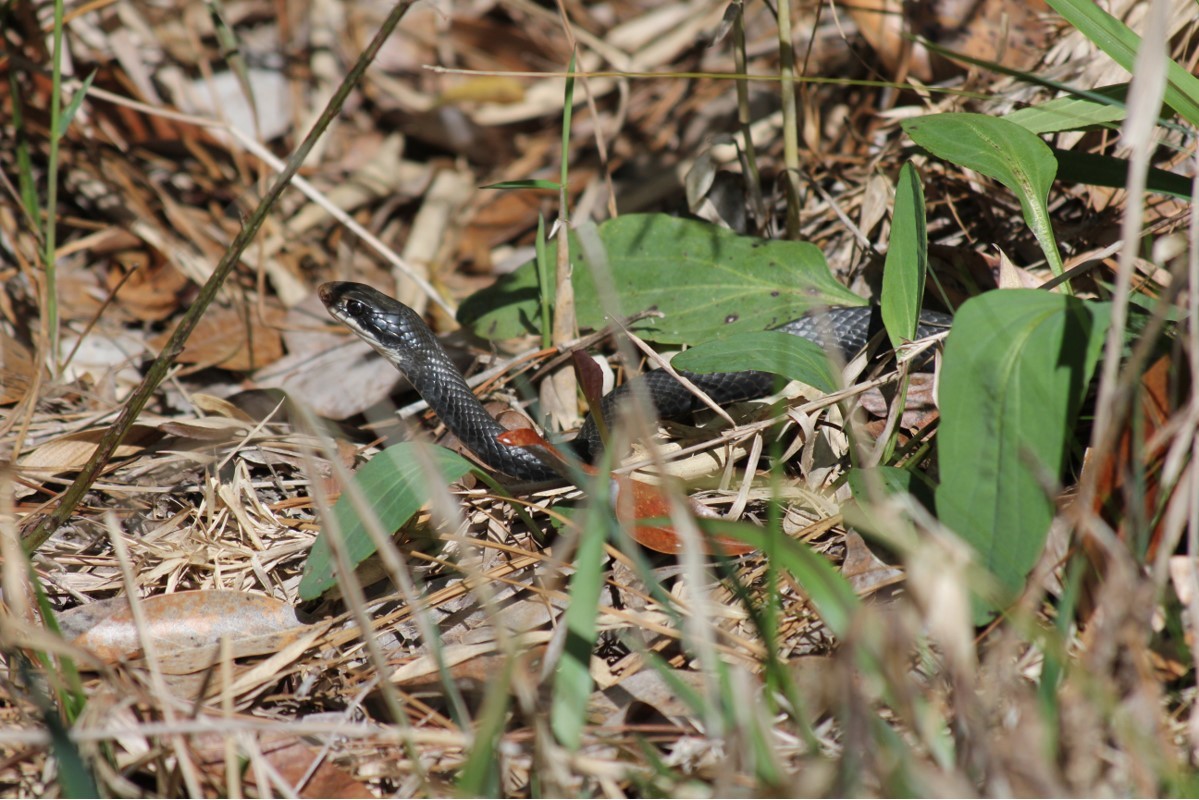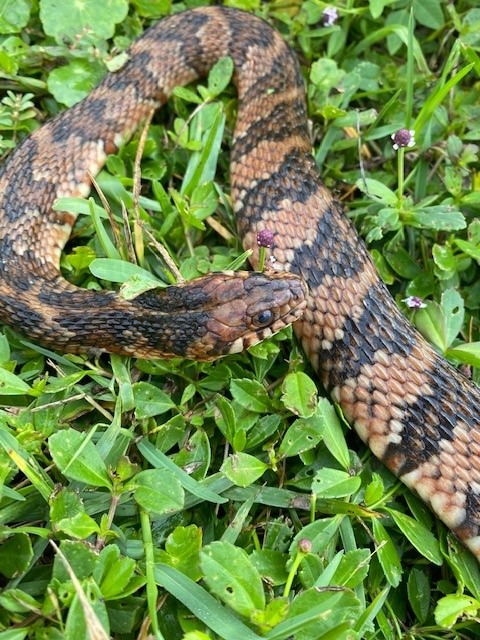Early in 2022 I decided to begin a survey of snakes in the Pensacola Bay area. The purpose was to find out which species were encountered and how often. Based on Snakes of the Southeastern United States by Dr. Whit Gibbons and Dr. Mike Dorcas (2005) there are 40 species that could be encountered in the Pensacola Bay area. These are divided into six subgroups – small snakes (1 foot or less), mid-sized snakes (2-4 feet in length), large snakes (4-8 feet in length), water snakes, venomous snakes, and non-native snakes. During the course of the year, citizens within the community will call in with the snake they had found, often with a photograph.
Small snakes. Of the 7 species of possible small snakes, 3 of them (43%) were encountered.
Florida red-bellied snake – 1 time
Pinewoods snake – 2 times
Southern ringneck snake – 3 times
This is pretty amazing actually. Small snakes are first, small, and hard to find. Second, they are more nocturnal in habitat, making them even harder to find. But found they were. Most who found them were in the state parks.

Photo: Jessica Bickell
Mid-sized snakes. Of the 8 species of possible mid-sized snakes, 4 of them (50%) were encountered.
Rough green snake – 1 time
Eastern garter snake – 3 times
Eastern ribbon snake – 13 times
Eastern hognose snake – 1 time
These are species that are more commonly encountered. Rough green snakes are difficult to find because they blend in SO well with the leaves of trees and are often missed – but they are quite common. Garter snakes and ribbon snakes look very similar and are both found near water. There is plenty of water in the Pensacola Bay area and so you would expect to see them. The eastern ribbon snake was one of the more common encountered in 2022 – and continues to be into 2023. The eastern hognose was once encountered quite frequently. Their numbers seem to be on the decline (though this is not confirmed). They are often mistaken for pygmy rattlesnakes thus lose their lives when found.
Large snakes. Of the 7 species of possible large snakes, 5 of them (71%) were encountered.
Eastern kingsnake – 1
Gray rat snake – 3
Red rat snake (corn snake) – 3
Southern black racer – 21 times
Eastern coachwhip – 5 times
Encountering large snakes makes sense, they are large and much easier to see. However, encounters with these are becoming less frequent – much of this probably due to the fact that they are large, people are afraid of snakes, and they are killed. The eastern kingsnake is one that is not often encountered anymore. There have been studies conducted on their decline, some think they should be considered for listing. They are harmless and actually consume venomous snakes – something people should appreciate. But it is a snake, and a large one, so more often than not they are killed. In the last decade I have noticed a decline in the gray rat snakes. Hiking around the Roy Hyatt Environmental Center they were pretty common – it has been a while since I have seen one. There is a lot of development going on around Roy Hyatt, which could be the cause of their decline. We did not see as many corn snakes around Roy Hyatt, but I did encounter them a lot camping at state parks. Not as much anymore. The southern black racer was the most frequently encountered snake in this survey. Though large, they are very fast and seem to have adapted well to human neighborhoods. They are also active during daylight hours when people are out and about. The eastern coachwhip is a close cousin of the southern black racer. Though found throughout the watershed they are most often encountered in our coastal areas and barrier islands – where a lot of people reside. They are somewhat secretive but seem to be still very common. The only two large snakes not encountered are two that are currently listed – the Florida pine snake and the Eastern indigo. These are VERY rare in the panhandle in general.

Photo: Jacqui Berger
Water snakes. Of the 13 species of possible water snakes, 6 of them (46%) were encountered.
Black swamp snake – 1 time
Glossy crayfish snake – 1 time
Midland water snake – 1 time
Banded water snake – 3 times
Brown water snake – 2 times
Green water snake – 1 time
First point of interest is the number of different species in this group – it is the largest group. This is due to the numerous waterways in the Pensacola Bay watershed and the fact that species from the Mobile delta, and the Apalachicola River system, can easily find their way here. These river pathways allow diversity to increase. Number two is that they are not encountered more often. Almost of the reports of these snakes were by fishermen on the Escambia River system. Sitting quiet at anchor the snakes feel safe to move and the fishermen would more often see them. Number three is that they are hard to tell apart. I hope to develop a hand-held field guide for identifying these snakes, but honestly the differences are minor, and it is not easy. Number four, most of these were encountered in the spring. In the summer and fall, they were only encountered in September.

Photo: Rick O’Connor
Venomous snakes. Of the 4 species of possible venomous snakes, 3 of them (75%) were encountered.
Cottonmouth – 15 times
Eastern diamondback rattlesnake – 5 times
Pygmy rattlesnake – 5 times
As you can imagine, these are the snakes that have most folks concerned. With kids and pets playing in the yard, knowing that venomous snakes are around is a bit unnerving. One point to make here is that of the 40 possible species to encounter, only 4 (10%) are venomous. I will add here that there are actually six species of venomous snakes in Florida. The southern copperhead and the timber rattlesnake prefer rockier terrain and are more common north of us. However, within the karst environment of the central panhandle these snakes have been encountered. I did not include them in the Pensacola Bay survey. The one venomous snake found here that was not encountered was the eastern coral snake. This snake prefers to move at night and under leaf litter hunting prey. They are here but rarely encountered – in the 2022 report they were never encountered. One last note on these is the frequency of encounters with the cottonmouth. At 15, it was the second most encountered snake in our area. They are obviously quite common and prefer locations near water – which we have plenty of. We always like to confirm these reports due to their similarities to the banded water snake – the photos were confirmed. I will also mention how frequent they are seen in brackish water environments – something of interest to me. I would like to conduct more surveys in the brackish areas of our estuaries for presence/absence of the cottonmouth. I will add that bites from cottonmouths are not common, and death from those bites is very rare. It has been stated that 95% of those bitten by venomous snakes are either trying to catch them or kill them. The lesson here is leave them alone and you should not have a problem. However, we understand there are some situations (like they are in your garage) where leaving them alone is not an option. If you ever have questions on how to handle one of these situations, contact your local county extension office.

Photo: Bob Jackson
Non-native snakes. There is only one non-native snake found in the Pensacola Bay area (that we know of). This is the Brahminy blind snake (or flowerpot snake). This is a very small snake (2 inches maybe), blueish in color, resembles a worm, and most often found (and spreads) in flower gardens and landscaping. They differ from worms in that they have scales. They lack eyes and hunt small invertebrates. It is usually gardeners who find them, but none were reported in 2022.
Seasons. Looking at the distribution of snake encounters over the course of the year you find…
Winter – 6 encounters
0 small snakes
1 mid-sized snake (eastern ribbon snake)
2 large snakes (corn snake, southern black racer)
1 water snake (glossy crayfish snake)
1 venomous snake (cottonmouth)
Spring – 34 encounters
0 small snakes
1 small snake (southern ringnecked snake)
3 mid-sized snakes (rough green snake, eastern garter snake, eastern ribbon snake)
4 large snakes (eastern kingsnake, gray rat snake, corn snake, southern black racer)
4 water snakes (black swamp snake, banded water snake, brown snake, western green water snake)
3 venomous snakes (cottonmouth, eastern diamondback rattlesnake, pygmy rattlesnake)
Summer – 31 encounters
1 small snake (southern ringnecked snake)
2 mid-sized snakes (eastern garter snake, eastern ribbon snake)
3 large snakes (corn snake, southern black racer, eastern coachwhip)
3 water snakes (banded water snake, midland water snake, brown water snake)
3 venomous snakes (cottonmouth, eastern diamondback rattlesnake, pygmy rattlesnake)
Fall – 20 encounters
3 small snakes (Florida red-bellied snake, pinewoods snake, southern ring-necked snake)
2 mid-sized snakes (eastern ribbon snake, eastern hognose snake)
3 large snakes (gray rat snake, southern black racer, eastern coachwhip)
0 water snakes
3 venomous snakes (cottonmouth, eastern diamondback rattlesnake, pygmy rattlesnake)
Snakes reported only early in the year
Glossy crayfish snake, rough green snake, eastern kingsnake, gray rat snake, black swamp snake, western green water snake
Snakes reported only during warmer months
Eastern garter, banded water snake, brown water snake
Snakes reported only late in the year
Eastern coachwhip, midland water snake
Snakes reported year round
Eastern ribbon snake, corn snake, southern black racer, cottonmouth, southern ring-necked, eastern diamondback rattlesnake, pygmy rattlesnake
NOTE: Water snakes were not encountered late in the year.
The top five encountered snakes.
- Southern black racer – 21 encounters
- Cottonmouth – 15 encounters
- Eastern ribbon snake – 13 encounters
- Eastern coachwhip – 5 encounters
- Eastern diamondback rattlesnake – 5 encounters
- Pygmy rattlesnake – 5 encounters
Discussion. In 2022, 21 of the 40 possible snake species (53%) were encountered by members of the public. Most were encountered during the spring and summer when both snakes and people are more active. The larger and venomous snakes were encountered more often – but they are larger and easier to see. Many of the smaller and mid-sized species are hidden most of the day. Water snakes were encountered early in the year and seem to disappear in the later half of the year. Whether this was due to a decline in activity or whether there were fewer fishermen this time of year could be possible explanations. I believe fishing occurs year-round and so this supports the idea that water snakes become more dormant in the fall.
This was the first year of these reports. It is hoped that public will continue to report sightings in 2023 and see if these trends hold.
 3
3
